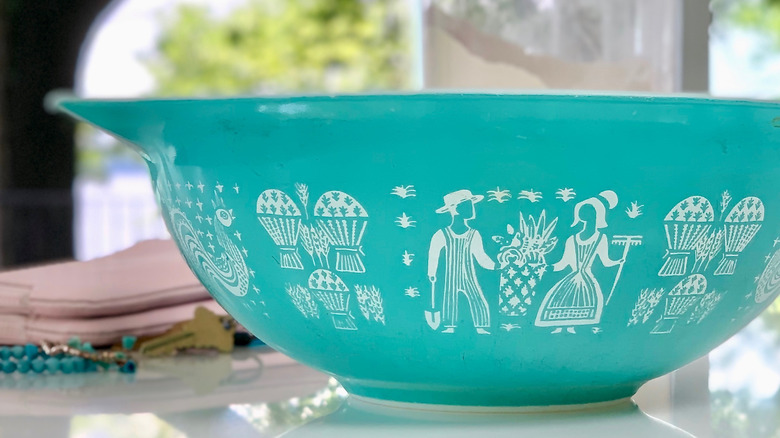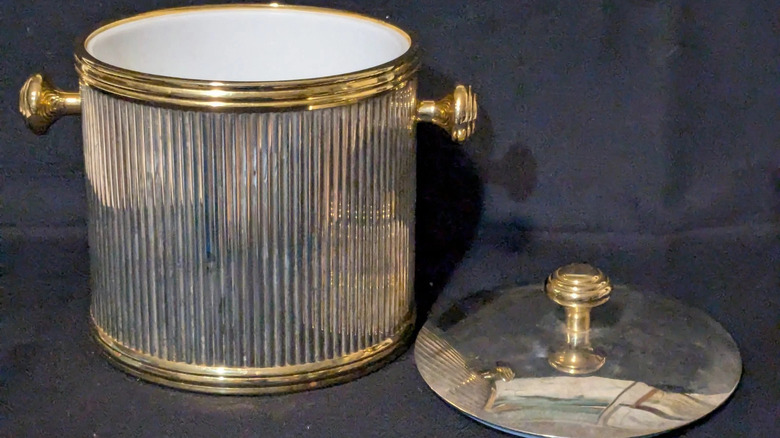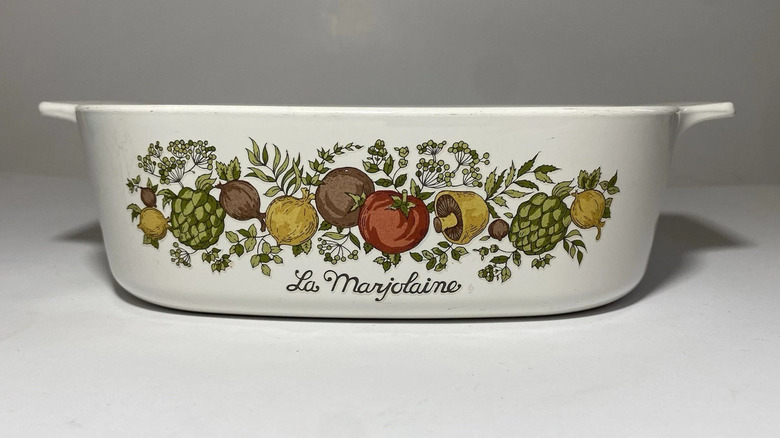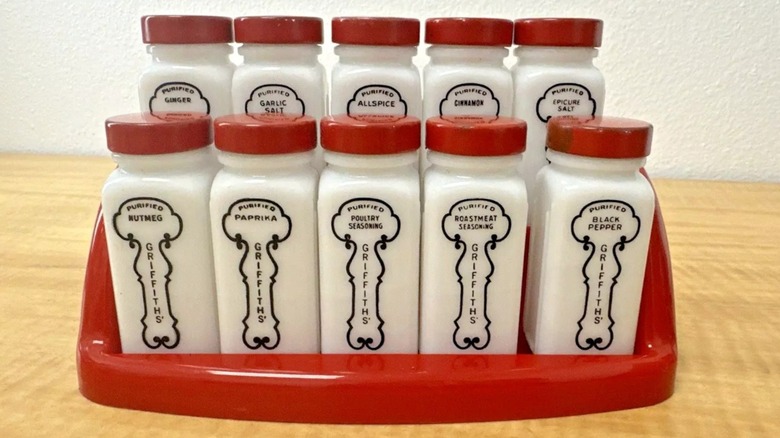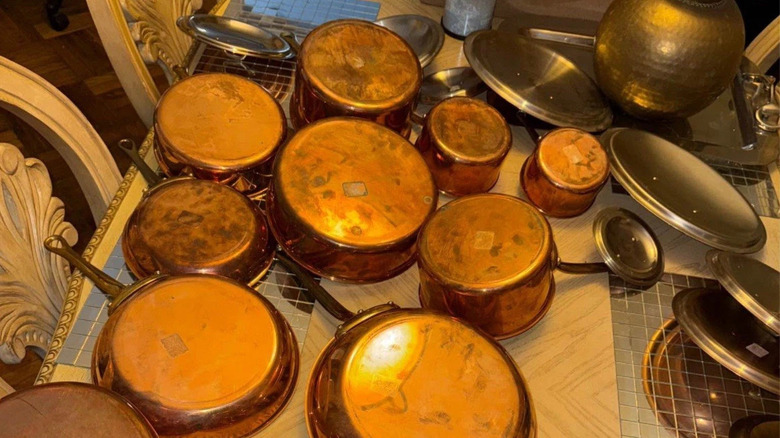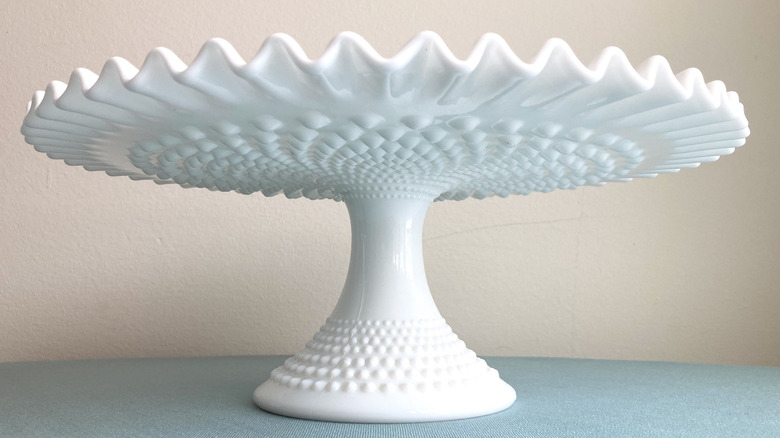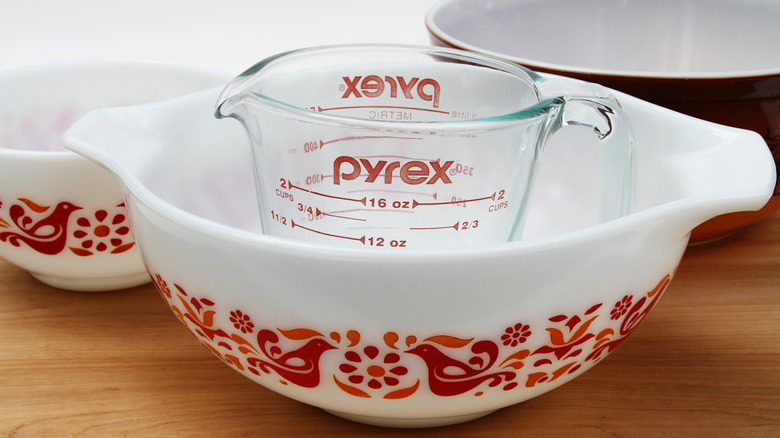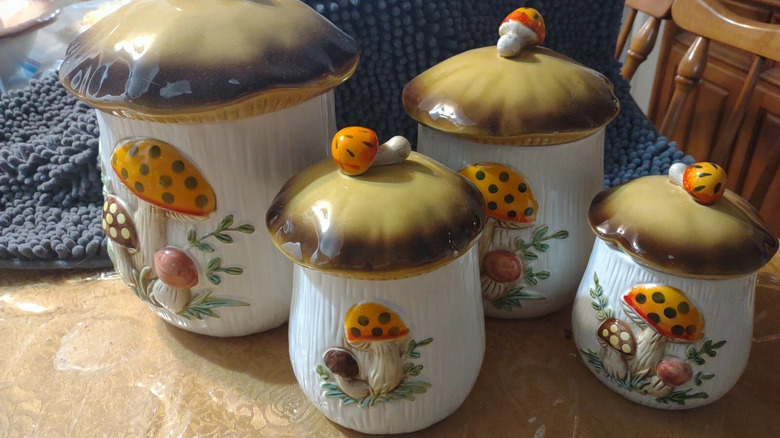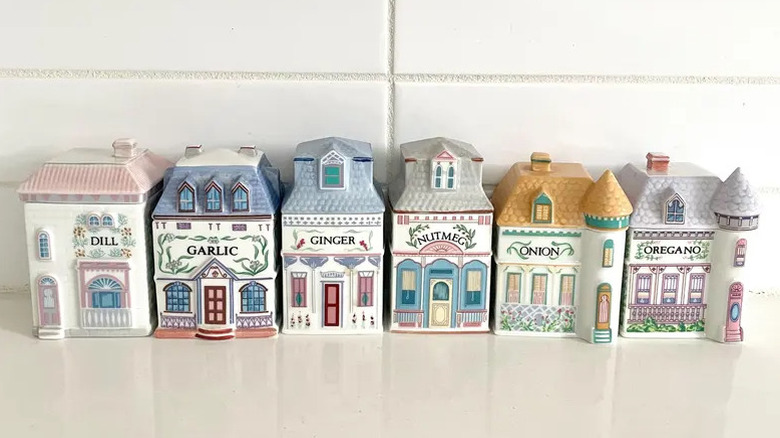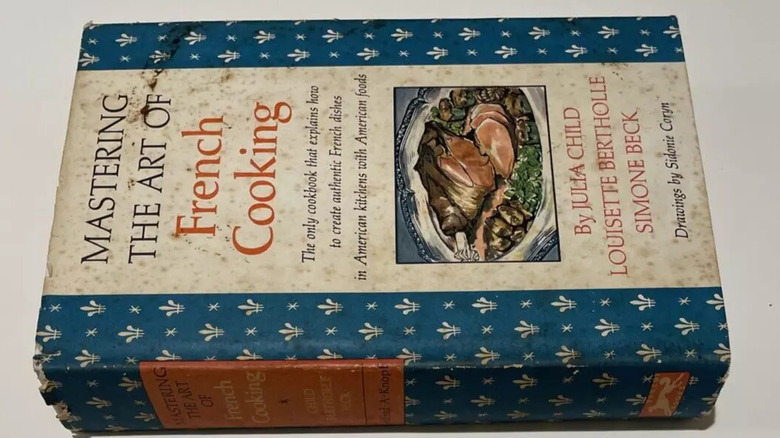Don't Toss These 11 Vintage Kitchen Items - They Could Be Worth A Fortune
We may receive a commission on purchases made from links.
With vintage kitchen accessories and styles making a comeback, you should really think twice before throwing away the old-fashioned kitchen gadgets and collections tucked in the back of your cabinets. Items from the 20th century are now considered vintage in the home decor world — what might look like dated miscellany could be worth a high price, and you may unknowingly have some valuable pieces tucked away in your kitchen. Some pieces might be made of expensive materials (hidden under years of tarnish), be collectors' items, form part of limited edition collections, or have practical use even today, making them valuable for homeowners and collectors alike.
Below are eleven vintage kitchen items that could be worth a small fortune. Of course, there are lots of factors that influence ultimate value, such as overall condition, rarity, and whether they're in complete sets. To make sure you don't unknowingly toss an expensive item from recent history, read on to learn how to recognize vintage kitchenware from reputable brands of the past and present.
Hallmarked silver and glass ice buckets from the early 20th century can command significant value
In modern times, an ice bucket can feel unnecessary when there are automatic ice makers for countertops or pre-installed ones in fridges. But if you come across one in storage, don't toss it without further examination, as it might be a valuable find. If it's made of crystal glass or solid silver, you could have a vintage ice bucket on your hands. Pieces made by centuries-old crystal manufacturers can be worth a pretty penny if they're still in good shape. They could make a great accent for elegant and vintage-style homes or net you a small sum of money if sold.
Hallmarked solid metal or glass ice buckets from the 19th and early 20th century are vintage collectibles. Some are worth over a thousand dollars, especially if they're from known luxury brands like Baccarat or Saint Louis that have been around for centuries. Ornate patterns are often carved in the glass and they may have gilded metal rims with intricate designs, and maker mark etched on the bottom. For example, Baccarat put "BACCARAT FRANCE" in all capital letters etched in the base of their glass kitchen items starting in 1936. Pristine pieces from renowned maker are often listed for a few thousand dollars. But, of course, not all vintage ice buckets are worth boatloads of cash. Depending on the marker, materials, rarity, and condition, even the prettiest vintage ice bucket might only attract between $50 and $100, in which case, we'd seriously consider keeping the piece as a stylish accessory.
CorningWare cookware dishes are coveted as collectibles and nostalgic pieces
The CorningWare brand has been around since the 1950s, and over the decades, they've released numerous collections of ceramic cookware and bakeware sets. Collectors often associate these different patterns with important events in history, such as the "Starburst" design that took off in the late 1950s to early 1960s during the space race. You can recognize vintage patterns by two notable stamps, often found on the bottom of the dish: a flame logo or "Made in the USA" text.
CorningWare dishes from the 1970s and tend to be the most valuable. In the 1970s, the "Spice of Life" lineup was released and became one of the most produced and purchased patterns. Many of these hard-wearing bakeware sets are still in great condition today, making them popular purchases on resale sites. One way that collectors evaluate CorningWare items is by examining the stamp underneath. Some early CorningWare stamps feature blue ink, CorningWare products made in the 1970s and 1980s were marked with a block stamp, and even older dishes produced during the 50s feature raised, embossed stamps.
The bigger the matching set (and the better the condition), the higher the value. If your household has a whole coordinated collection stuffed away in the kitchen, you could continue putting it to use, display it, or, if vintage items aren't your style, list it online. If you plan on using vintage CorningWare, identify whether it's ceramic or glazed stoneware. Ceramic dishes can take temperature extremes (like being taken from the freezer and placed in the oven), but stoneware should be reserved for baking, and preferably not at ultra-high heat. Non-rare (but still popular) CorningWare items from the 80s in fair condition are generally worth between $20 and $40. Rarer, older, and more mint casserole dishes typically sell online for between $50 and $500, with prices averaging between $100 and $150.
Griffith Laboratories spice jars are another cute collectible to keep
Griffiths' Lab spice jars took off in the 1930s and 1950s and were sold in sets of eight to 24 that also came with their own miniature stands or spice cabinets. As post-war families had to watch their wallets, these spices wrapped up in pretty bottles were an attractive deal, as you got the seasonings plus some cute kitchen decor. Besides being a snag, the Griffiths' spice jar sets also gave housewives access to less common seasonings like curry, sage, mace, bay leaves, etc. Mixed seasonings were also present in the mix, such as "poultry seasoning" or "roast meat seasoning."
You can recognize a Griffiths' spice jar by its milk glass body and metal screw-on lid. The racks were made of metal, then plastic, and later on, wood. The bottles were either a white or dusty brown color, and the lids came in various shades. The labels say, "Griffiths" on the front and "The Griffith Laboratories" on the back. Early editions of the jars featured molded-on labels, which were later replaced with paper ones. A lot of surviving sets have lost their original paper labels, but the jars have become so popular that a market for replacement labels and lids has sprung up. Selling a set of these spice jars won't make you rich (as sets tend to sell for under $50-$100) — but they're definitely not old kitchen junk. The Griffiths' spice bottles are iconic collectibles that can bring an Art Deco flavor to your kitchen decor, fetch up to a hundred bucks (especially if you also happen to have the stand), or be kept to potentially appreciate in collectability.
Vintage copper pots can command high prices
If you uncovered a tarnished copper pan in a box of old kitchenware, press pause before tossing or sending to your local Goodwill. Aged copper pots are often passed down through generations, and their value can grow with age, unlike most modern-day pots and pans. There are several reasons this once-dated kitchen staple is now a must-have collectible. Besides holding historic value, vintage copper pots and pans can be a practical asset to your kitchen since they heat up and cool down quickly, giving supreme control over the cooking process. The inside should have a metal liner to keep food from touching exposed copper. Vintage products often had a tin liner, which wears away over time, exposing cooking food to the copper, which is reactive and can be toxic in large amounts. If you plan to keep or sell the pan or pot as a pure collectible, then exposure isn't an issue, but it should be re-tinned if you're planning to cook in it.
Even new copper pans and pots are valuable and command high price points — but vintage pieces may be worth more based on the age and maker. Look for stamping on the side that indicates who made the pan. You may even find stamps indicating the store that sold it, identification numbers, or former owners' initials. Stamps from makers like "H. Pommier Bruxelles" indicate the piece was made by a coppersmith in the 20th century, though the exact dates are inconclusive. Peter Brux, Mauviel-Gautier, and Mora and Matfer are also common stamps seen on 20th-century copperware. Another way to identify a truly handcrafted and vintage piece is to look for hammer marks on the sides and handcrafted rivets in the handles. The size and thickness of the pan, as well as what type of lining it has, also affects the value. Although truly rare, older pieces that cross the line into antique territory can sell for over $1,000, most vintage pans will be worth less than this, averaging out to a few hundred dollars, and ranging down if they don't carry a maker mark.
Fenton cake stands are beloved for their intricate details and collectability
Twentieth-century art glass cake stands are another set of valuable vintage kitchen items, which can also can boost your kitchen's aesthetic appeal. These gorgeous, handcrafted cake stands were crafted by reputable glassmakers at the time, including the Fenton Art Glass Company, and have become collectibles. Standalone cake stands may only fetch a hundred dollars or so, but if you find a whole set, including cake plates, you could have an enviable collection.
Many of the Fenton Art Glass Company's cake stands are recognizable by the ornate designs across the entire stand. Their "Hobnail" cake stand design had a ruffled rim (known as Spanish lace) and raised hobnail boot pattern across the top and pedestal. Unfortunately, they branded these items with stickers that are likely to have torn off over the years. Although often fashioned out of milk glass, some cake stands also came in opalescent and uranium glass. If there is still a sticker on your item, you can identify the year it was made (and if it's truly a Fenton Art Glass product) by comparing it to the chart on their webpage Fenton Label History. On eBay, Fenton cake stands generally sell for under $100, but on marketplaces like Etsy and 1stDibs, the prices are higher, typically ranging between $100-$200.
Vintage Pyrex casserole dishes are both practical and collectible
Pyrex is a household name, and they mass produce kitchenware even now. This company has been around for ages, and their vintage cookware could fetch a pretty price if you find a whole set in your cabinets. Pyrex products sport an array of patterns from vibrant red and orange floral motifs to muted brown and beige bowls with retro imaging on the side. According to a chart by the Valuable Antique Detector, Pyrex patterns from the 1950s to 1980s are the rarest and priciest. The best way to recognize a vintage Pyrex dish is to examine the logo on the bottom and to know the difference between the "PYREX" and "Pyrex" labels on cookware. Vintage products have the Pyrex name in all caps, and glass items should be quite heavy, as they are made of borosilicate glass. Borosilicate is overall more durable than the soda lime material Pyrex uses now, making it sturdier and safer for various cooking ventures. Given this fact, it makes sense why people are willing to pay more for the vintage version of this brand — it is actually superior to most newer products.
The pricing of vintage Pyrex varies widely, and several factors influence the value: the condition, number of pieces, and the pattern and rarity (for instance, promotional Pyrex items are often pretty rare). Depending on the rarity of the pattern, a complete set of bowls that's in good condition could be worth anywhere from somewhere over $100 to $400. Highly rare dishes, patterns, and pieces with factory imperfections can sell for even more.
Sears Merry Mushroom kitchen coordinates are surprisingly serious collectibles
The adorable mushroom trend in home decor isn't a brand-new concept — a mushroom-style kitchen set also took off in the 1970s. Sears released a "Merry Mushroom" kitchen coordinates collection with polka-dotted mushrooms emblazoned on the sides of cookware, storage jars, teapots, mugs, and other kitchen products. At the time, themed kitchens were in style, and the idea was that people could pick up matching items with the same pattern for both the kitchen and dining room. If you come across some of these cute coordinates in storage, you can embrace the nostalgia (they're perfect cottagecore decor) or resell if retro mushroom motifs are just not your style and you're looking to declutter.
Merry Mushroom items feature one to three (often sculpted) mushrooms in bright orange, yellow and brown colors on a white background, with brown lids shaped like mushroom caps, often sporting a small mushroom knob. The overall look is very intricate and creative and they're hand-embossed. There are also matching plates, pots, etc, featuring flat designs. A large set of coordinates in good condition can be worth hundreds of dollars. For instance, a set of Sears Roebuck & Co Merry Mushroom Pots and Pans with Lids is listed for roughly $626 on Etsy. The Merry Mushroom canisters in good condition seem to range around $70 each, depending on size.
Vintage Le Creuset cookware can be relatively valuable
Allegedly the first company to widely produce Dutch ovens, this French cookware brand is known for its highly durable enamel-coated cast iron that was released throughout the 20th century, starting in the 1920s. Originally, Le Creuset's lineup took off in popularity due to its eye-catching colors and chip-resistant performance, and these same attributes have kept it a hot favorite ever since — prized by serious chefs, homemakers, and aesthetically conscious, occasional cooks alike. To add fuel to the fire, Le Creuset has a habit of discontinuing colors and making many of their dishes limited editions. For instance, they recently discontinued the highly popular "Meringue" colorway.
If you're wondering whether that 12-pound pot hiding in the attic is a Le Creuset, simply flip it over. The brand makes it easy to identify their cookware by engraving their name across the bottom. There may also be a smaller engraving that says "France" or "Made in France" and a number that indicates the size of the pan. Whether you want to start braising brisket right away, or are thinking of reselling — first check the enamel coating. If the enamel has broken away on the interior, you shouldn't cook with it. While some people still use chipped enamel Dutch ovens to bake bread, enamel cast iron companies generally advise against any use, as further chips could get into the food. Exterior chips are less serious and just need to be dried properly to ensure they don't rust.
If you want an idea of how much these items go for, this Le Creuset Flame Orange Set of Pots and Pans (which sports some damage) goes for about $668 on Etsy. On average, medium-sized individual pots can easily sell for over $100. Given that a new Le Creuset Dutch oven can set you back over $500, unless you've taken a vow never to cook — we'd hang on to any vintage ones you've found hiding out in your home and put them to use, even if it's as an ice bucket (yes, that's a thing).
Lenox spice jars are another collectors'-level item
Lenox is another spice jar brand that gives Griffith Laboratories a run for its money, competing as one of the more expensive vintage spice sets. The Lenox Corporation came out with a unique idea in the 1980s, releasing their "Spice Village" collection, which housed spices in adorable little dollhouses. Thanks to popular demand, this spice village just made a sudden return after a 35-year hiatus, releasing a modern version back into the market. Allegedly, this new release hasn't impacted the popularity of the vintage versions, and the original edition is still in high demand by collectors. There is no significant difference in the second edition except a back stamp that identifies the newer release, and the fact that it's a lot less expensive than the originals.
Even the individual canisters from the original edition are pricey, which is understandable given the adorable these hand-painted, gold-accented spices houses are. Certain spices are also worth more than others, depending on rarity. For example, in this Etsy listing, the standalone basil is listed at around $95, while the cheese and garlic is $255. On other listing sites, there's a similar disparity in price, ranging from around $5 to over $200 per house depending on condition and demand. The complete sets are guaranteed to be more expensive, costing between about $400 to $1,800 depending on the style and rack.
First edition and signed vintage cookbooks can be quite valuable
When coming across an older cookbook that's been passed down through the family, take a second look before donating it. If it's from the previous century, in readable condition, and an authentic publication, it could be worth more than you expect. It's not because the recipes inside are groundbreaking but because the books themselves hold history. Old cookbooks are a direct look into the past decades. They are written documentation of cooking habits and practices, and many of them were written by the "Gordon Ramsays" of previous generations. Books also weren't mass-produced at the same level back in the day as they are now. Old books have a nostalgic and unique feel, with their carefully bound pages, artistic drawings, and typography. In short, you're better off holding onto any dusty vintage volumes, being careful to preserve the condition, or selling to a book collector, chef, or other interested buyer.
As far as value goes, first editions in good condition and copies signed by renowned chefs like Edna Lewis and Julia Child tend to attract the most value. But, obscure, small-town cookbooks can also be a collectible, thanks to their small print runs, which renders some quite hard to come by. You can identify a first-edition cookbook by the statement on the copyright page. It should have a line saying "First Edition" or "First Printing". There should also be a line of numbers which will include "1" if it is truly a first edition. Ultra rare first editions of iconic cookbooks have allegedly sold for thousands at auction, however, most vintage cookbooks (in good condition) are probably worth somewhere between $20 to $200, depending on their author and status as a collectible.
